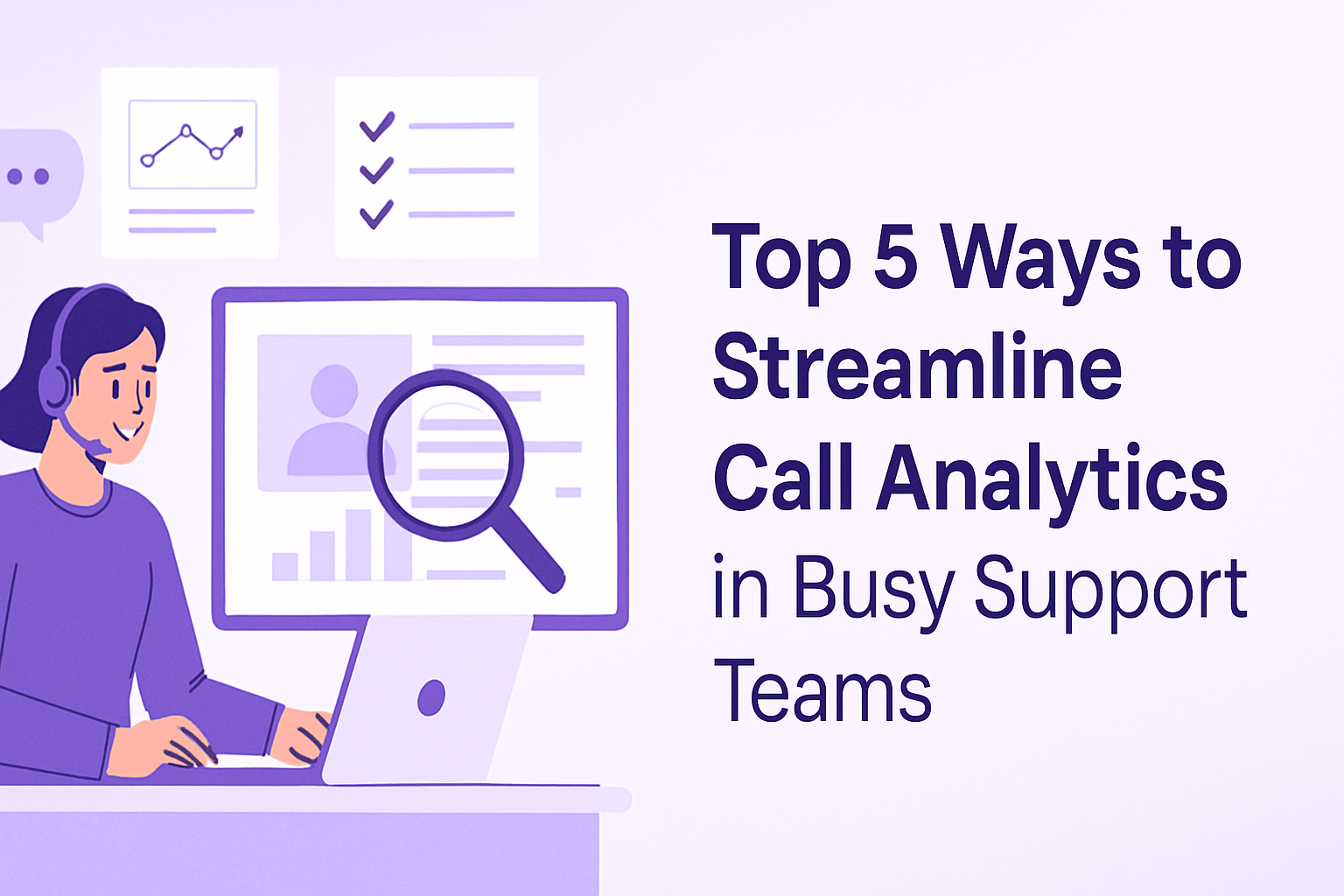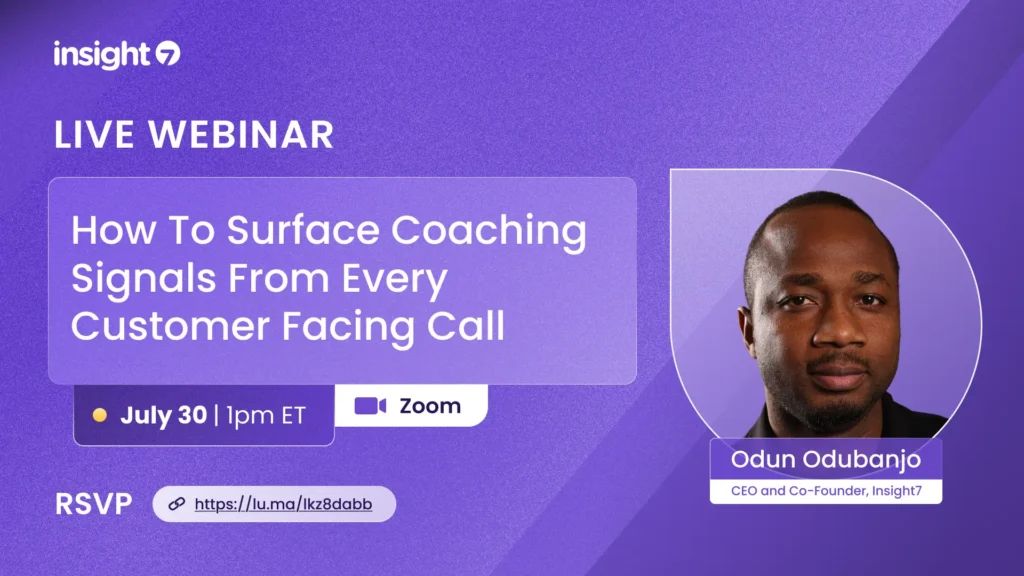How To Measure The Impact of Sales Training with Call Analytics
-
Hello Insight
- 10 min read
How To Measure The Impact of Sales Training with Call Analytics
Measuring the effectiveness of sales training programs can often feel like navigating a maze without a map. Organizations need clear insights to understand how training impacts performance, and call analytics provides a powerful solution. This guide explores how leveraging call analytics can help businesses assess the value of their sales training initiatives, ultimately leading to improved sales performance and customer satisfaction.
The Role of Call Analytics in Modern Sales Training
In today’s competitive business landscape, understanding the effectiveness of sales training is crucial for success. Call analytics offers a systematic approach to evaluate training outcomes by analyzing real customer interactions. This data-driven method shifts the focus from traditional, subjective performance reviews to a more objective analysis of actual sales calls, enabling sales teams to refine their strategies and improve customer engagement.
By utilizing call analytics, organizations can transition from reactive methods—where feedback is often anecdotal—to proactive strategies that inform training programs in real-time. This transition fosters alignment between sales, training, and customer service teams, creating a unified approach to improving customer interactions.
To effectively leverage call analytics, organizations need a robust infrastructure that integrates various data sources, ensuring comprehensive analysis and actionable insights.
What is Call Analytics?
Call analytics refers to the process of collecting, measuring, and analyzing data from sales calls to evaluate agent performance, assess customer interactions, and drive strategic decision-making. Unlike traditional approaches that often rely on retrospective analysis of call outcomes, call analytics provides real-time insights into sales conversations, enabling businesses to identify strengths and weaknesses in their training programs.
Core Capabilities:
- Performance Evaluation: Measure individual and team performance based on predefined criteria, providing a clear picture of training effectiveness.
- Customer Insights: Analyze customer sentiment and feedback during calls to understand how training impacts customer experience.
- Trend Identification: Spot patterns in customer interactions to tailor future training sessions more effectively.
- Actionable Reports: Generate detailed reports that inform strategic decisions, optimizing sales training and operational efficiency.
Strategic Value: By utilizing call analytics, organizations can make informed decisions that enhance training programs and improve overall sales performance.
Why Are Consultants and Insight-Seeking Personnel Investing in Call Analytics?
Organizations are increasingly moving away from outdated training evaluation methods to embrace call analytics due to several key drivers:
- Increased Demand for Data-Driven Insights: Traditional performance reviews often lack depth, leading to the adoption of analytics that provide a more fact-based assessment of training outcomes.
- Need for Speed: Businesses require quick access to data to adapt training programs in real-time, ensuring they remain relevant and effective.
- Enhanced Personalization: Call analytics allows for targeted feedback based on individual agent performance, leading to more tailored training initiatives.
- Optimization of Resources: By analyzing call data, organizations can allocate resources more effectively, maximizing the impact of training programs.
What Data Powers Call Analytics?
To build effective call analytics systems, organizations need comprehensive data inputs that allow for robust analysis. This necessitates a multi-modal approach that incorporates various data sources:
- Call Transcripts: Detailed scripts of sales calls that provide context for analyzing interactions.
- Customer Feedback: Surveys and post-call feedback that highlight customer experiences.
- Agent Performance Metrics: Quantitative data on sales outcomes, conversion rates, and customer responses.
- Historical Data: Past sales calls that serve as a benchmark for evaluating current performance.
- Sentiment Analysis: Tools that assess customer emotions based on language used during calls.
By integrating these diverse data sources, organizations can enhance the accuracy and reliability of their call analytics, leading to better insights and more effective training programs.
Key Components of a Call Analytics Stack
To effectively implement a call analytics strategy, organizations must consider several critical components:
- Data Collection: Mechanisms for aggregating data from various sources, including call recordings and customer feedback.
- Analysis Engine: Tools that process call data to identify trends, performance metrics, and areas for improvement.
- Reporting Framework: Systems for generating reports that summarize findings and recommend actions based on data analysis.
- Learning Mechanism: Capabilities that allow for continuous improvement of training programs based on insights gleaned from call data.
- Visualization Tools: Dashboards that present findings in an accessible format for stakeholders to understand and act upon.
Quality Emphasis: The effectiveness of call analytics hinges on the quality of the data collected and the interpretability of the insights derived.
Success Dependency: Organizations need to ensure that they're capturing high-quality input signals to maximize the effectiveness of their analytics efforts.
How Does Call Analytics Work Step by Step?
Step 1: Data Collection
Call recordings and customer feedback are gathered from various channels, providing the raw data needed for analysis.
Step 2: Data Processing
The collected data is processed through an analysis engine that applies algorithms to evaluate agent performance and customer sentiments.
Step 3: Trend Identification
Patterns in the data are identified, revealing insights into agent strengths and weaknesses, as well as customer preferences and pain points.
- Pattern type 1: Common objections encountered by agents.
- Pattern type 2: Successful phrases or strategies that lead to conversions.
- Pattern type 3: Areas where customers express dissatisfaction.
Step 4: Training Insights
The insights derived from the data are used to inform training sessions, ensuring that agents receive targeted coaching based on real-world interactions.
Step 5: Continuous Monitoring
Real-time monitoring systems track ongoing performance, allowing for immediate adjustments to training strategies as needed.
Step 6: Reporting and Recommendations
Detailed reports are generated, outlining performance metrics and offering actionable recommendations for improvement.
- Example output 1: A summary of agent performance over a specific period.
- Example output 2: Insights into customer sentiment trends.
- Example output 3: Recommendations for targeted training sessions based on performance gaps.
Where Can Consultants and Insight-Seeking Personnel Apply Call Analytics?
Enhanced Training Programs
- Prediction method: Use data to predict areas where agents may struggle based on past performance.
- Recommended action: Implement targeted training sessions that address identified weaknesses.
Performance Review Optimization
- Analysis approach: Score agent performance based on call analytics.
- Follow-up action: Provide personalized feedback and coaching opportunities.
Customer Experience Improvement
- Identification method: Analyze customer feedback for common complaints and issues.
- Proactive intervention: Develop strategies to address recurring concerns highlighted through call data.
Resource Allocation
- Forecasting approach: Use analytics to predict peak call times and necessary staffing levels.
- Optimization action: Allocate resources more effectively to meet customer demand.
What Tools Can You Use for Call Analytics?
Organizations seeking to implement call analytics should look for platforms that integrate seamlessly with their existing systems and offer robust analytical capabilities.
Comparison Table:
| Feature | Insight7 | Traditional Alternative |
|---|---|---|
| Real-time analytics | Yes | No |
| Automated reporting | Yes | Limited |
| Sentiment analysis | Yes | No |
| Performance scoring | Yes | Manual |
| Integration capabilities | High | Moderate |
Common Pitfalls in Call Analytics Implementation
Context Warning: Many organizations face challenges when implementing call analytics due to a lack of strategy or understanding of the required processes.
Major Pitfalls:
- Ignoring Data Quality: Poor data quality leads to inaccurate insights and ineffective training.
- Lack of Stakeholder Alignment: Without buy-in from key stakeholders, implementation efforts may falter.
- Neglecting Integration Capabilities: Failing to integrate analytics with other systems can limit effectiveness.
- Overlooking Continuous Improvement: Analytics is an ongoing process that requires regular updates and refinements.
Success Foundation: Effective implementation begins with a clear strategy that aligns all stakeholders around shared goals.
How Do You Get Started with Insight7?
Step 1: Integration Setup
Ensure that Insight7 integrates with existing platforms to streamline data collection.
Step 2: Data Synchronization
Establish processes for syncing data from various sources, including CRM systems and call recordings.
Step 3: Configuration
Customize the platform to meet the specific needs of your organization, including setting performance evaluation criteria.
Step 4: Training Sessions
Leverage historical data to inform training sessions, ensuring that agents are equipped with the knowledge they need.
Step 5: Continuous Optimization
Regularly review and refine the analytics process based on new data and feedback from agents.
What Is The Best Call Analytics Setup?
ROI Optimization: To ensure maximum return on investment, organizations should prioritize the following best practices:
- Diversify Data Sources: Utilize a variety of data inputs for more comprehensive insights.
- Engage Stakeholders: Involve key stakeholders in the implementation process to ensure alignment.
- Utilize Historical Data: Leverage past performance to inform current training initiatives.
- Establish Review Cadences: Regularly review analytics to adapt training strategies as necessary.
- Integrate Automation: Use automated tools to streamline data processing and reporting.
Building a Call Analytics Strategy That Scales
A scalable call analytics strategy requires cross-functional collaboration. Different teams must jointly define objectives, data requirements, and processes for ongoing refinement to ensure that insights lead to actionable improvements.
Call Analytics Benchmarks and Success Metrics
Evaluation Framework: Clear benchmarks are essential to measure the impact of call analytics on sales training.
Core Metrics:
- Call conversion rates (measures the percentage of calls that result in sales).
- Customer satisfaction scores (assesses how well customer needs are met).
- Agent performance scores (evaluates individual agent effectiveness).
- Training effectiveness ratings (measures improvements post-training).
- Feedback response times (assesses how quickly agents address customer concerns).
Universal Principle: Consistent evaluation and adaptation of strategies based on metrics will drive better decision-making and business outcomes.
Frequently Asked Questions
Q: What is call analytics?
A: Call analytics involves analyzing data from sales calls to measure performance, understand customer sentiment, and improve training.
Q: How does call analytics differ from traditional methods?
A: Unlike traditional methods that rely on historical assessments, call analytics provides real-time insights into agent performance and customer interactions.
Q: Is Insight7 compatible with my existing systems?
A: Yes, Insight7 is designed to integrate with a variety of platforms, enhancing its utility across different systems.
Q: What type of data is required for effective call analytics?
A: Ideal data sources include call transcripts, customer feedback, agent performance metrics, and historical call data.
Q: How long does it take to see results from implementing call analytics?
A: The timeline varies by organization, but many see improvements within a few weeks of implementation.
Q: What security measures are in place with call analytics?
A: Call analytics platforms typically adhere to industry standards for data security and compliance, ensuring protection of sensitive information.






